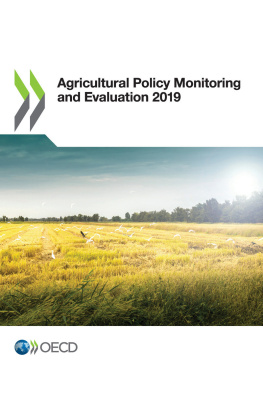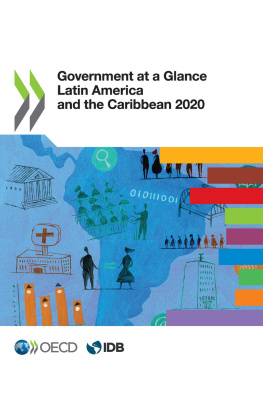OECD - Pensions at a Glance 2019
Here you can read online OECD - Pensions at a Glance 2019 full text of the book (entire story) in english for free. Download pdf and epub, get meaning, cover and reviews about this ebook. year: 2019, publisher: OECD Publishing, genre: Politics. Description of the work, (preface) as well as reviews are available. Best literature library LitArk.com created for fans of good reading and offers a wide selection of genres:
Romance novel
Science fiction
Adventure
Detective
Science
History
Home and family
Prose
Art
Politics
Computer
Non-fiction
Religion
Business
Children
Humor
Choose a favorite category and find really read worthwhile books. Enjoy immersion in the world of imagination, feel the emotions of the characters or learn something new for yourself, make an fascinating discovery.
Pensions at a Glance 2019: summary, description and annotation
We offer to read an annotation, description, summary or preface (depends on what the author of the book "Pensions at a Glance 2019" wrote himself). If you haven't found the necessary information about the book — write in the comments, we will try to find it.
OECD: author's other books
Who wrote Pensions at a Glance 2019? Find out the surname, the name of the author of the book and a list of all author's works by series.
Pensions at a Glance 2019 — read online for free the complete book (whole text) full work
Below is the text of the book, divided by pages. System saving the place of the last page read, allows you to conveniently read the book "Pensions at a Glance 2019" online for free, without having to search again every time where you left off. Put a bookmark, and you can go to the page where you finished reading at any time.
Font size:
Interval:
Bookmark:

OECD (2019), Pensions at a Glance 2019: OECD and G20 Indicators , OECD Publishing, Paris, https://doi.org/10.1787/b6d3dcfc-en .
The information in this document with reference to Cyprus relates to the southern part of the Island. There is no single authority representing both Turkish and Greek Cypriot people on the Island. Turkey recognises the Turkish Republic of Northern Cyprus (TRNC). Until a lasting and equitable solution is found within the context of the United Nations, Turkey shall preserve its position concerning the Cyprus issue.
The Republic of Cyprus is recognised by all members of the United Nations with the exception of Turkey. The information in this document relates to the area under the effective control of the Government of the Republic of Cyprus.
This eighth edition of Pensions at a Glance provides a range of indicators for comparing pension policies and their outcomes between OECD countries. The indicators are also, where possible, provided for the other major economies that are members of the G20. Three special chapters provide a deeper analysis of recent pension reforms (Chapter 1) and pension systems within OECD countries for individuals in non-standard forms of work (Chapters 2 and 3).
This report was prepared under the general supervision of Gabriela Ramos, OECD Chief of Staff and Sherpa to the G20. It is the joint work of staff in both the Pensions Team of the Social Policy Division of the OECD Directorate for Employment, Labour and Social Affairs and of the Insurance, Private Pensions and Financial Markets Division of the OECD Directorate for Financial and Enterprise Affairs. National officials particularly delegates to the OECD Working Party on Social Policy and members of the OECD pension expert group provided invaluable input to the report.
Chapter 1 on Recent pension reforms was written by Boele Bonthuis and Tomoko Onoda. Chapter 2 entitled Non-standard forms of work and pensions was written by Maciej Lis, Marius Lske and Tomoko Onoda. Chapter 3 entitled Are funded pensions well designed to adapt to non-standard forms of work? was written by Stphanie Payet and Pablo Antolin thanks to the financial support of the European Commission and Principal International Group. Chapters 4 to 8 were written and the indicators therein computed by Christian Geppert and Andrew Reilly, while Chapter 9 was written by Romain Despalins, Stphanie Payet and Pablo Antolin, who also computed the related indicators. Herv Boulhol led the team and was responsible for revising and enhancing these chapters. Maxime Ladaique provided extensive support for tables and figures. Lauren Thwaites prepared the manuscript for publication. Fatima Perez provided technical assistance.
We are grateful to many national officials including ELSAC Delegates and to colleagues in the OECD Secretariat for their useful comments, notably Andrea Garnero, Herwig Immervoll, Marguerita Lane, Horacio Levy, Mark Pearson, Monika Queisser and Stefano Scarpetta (ELS), Anna Milanez (CTP) and Stphanie Payet (DAF). The OECD gratefully acknowledges the financial support from the European Union, which co-financed this project with the OECD.
The world of work is changing. Mega trends, such as digitalisation, globalisation, and demographic and climate change are transforming our economies and societies. Many new opportunities for growth and development are emerging, but also some clear challenges with increasing numbers of people with unstable working conditions, often in temporary or part-time jobs, and with low and intermittent earnings. New technologies make it easier and cheaper to offer and find work on-line, and platforms have seen an exponential growth in recent years, even if they still account for a small share of employment across the OECD. Overall, non-standard employment, including self-employment, accounts for more than one in three jobs in OECD countries. Non-standard workers are a very diverse group, but on average, they earn less on an hourly and especially yearly basis. For example, a median full-time self-employed person earns 16% less than a full-time employee, on average across the OECD.
What does this mean for workers social protection? Most social protection systems were built on the premise of stable, linear careers, often with only one employer, and thus are ill equipped to provide adequate income security for non-standard workers. Many of them, be it in self-employment, short-term, gig, platform or click work, risk falling through the cracks.
These developments challenge all branches of social protection, but one stands out in particular due to its long-term impact: the provision of old-age security. For pensions, the future of work is now. Many countries have tightened the links between contributions and pension benefits and thus, to reach an adequate pension, contributions have to start early and continue for the whole career. Countries have long recognised this; they have therefore made membership in pension systems mandatory for most workers and are encouraging participation in voluntary occupational and personal pension plans.
But as always, the devil is in the detail. Workers on fixed-term contracts should in theory be covered, as most countries align rules with those for standard workers. The problem is largely about the level of expected benefits given their patchier and generally lower contributions. However, in some countries, for some specific groups, reduced or no pension contributions are required for self-employed workers, temporary agency workers, young workers, seasonal workers, apprentices and/or trainees.
Ensuring pension coverage for the self-employed is much more difficult. Without a formalised employment relationship, it is not clear on what basis pension contributions should be levied. For employees, contributions are often based on the gross wage, but this does not correspond to any category of a self-employed workers earnings. Also, it is very difficult, if not impossible, to distinguish between labour and capital income. Still, most OECD countries require the self-employed to contribute to their mandatory pension systems. Why then is pension coverage still a challenge?
Font size:
Interval:
Bookmark:
Similar books «Pensions at a Glance 2019»
Look at similar books to Pensions at a Glance 2019. We have selected literature similar in name and meaning in the hope of providing readers with more options to find new, interesting, not yet read works.
Discussion, reviews of the book Pensions at a Glance 2019 and just readers' own opinions. Leave your comments, write what you think about the work, its meaning or the main characters. Specify what exactly you liked and what you didn't like, and why you think so.















